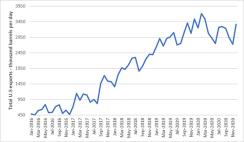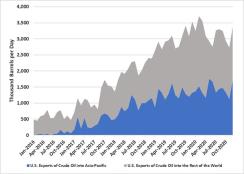By Paul Wightman, CME Group
AT A GLANCE
- Since the lifting of the crude oil export ban in 2016, U.S. oil exports to Asia have gone from near zero to 45% of total exports
- Europe received 15% more crude from the U.S. in 2020, partly driven by the fall in production of key European crude grades

Total U.S exports reached over 3-million barrels per day in 2020. Source: EIA
Asia and Europe Receiving Higher Volumes
The largest export destination for U.S crude oil in 2020 was China at 482,000 barrels per day, in part due to the China-U.S phase one trade deal. China was also one of the first countries to re-emerge following the global coronavirus pandemic.
More broadly, Asia has been a major beneficiary of the rise in U.S crude oil exports. In the past five years, U.S. crude shipped to Asia has grown from nearly zero to reach about 45% of total exports. China, India and South Korea were the largest Asian importers of U.S crude oil in 2020 with total volumes of just over 1 million barrels per day, an increase of 25% on 2019. Other economies in the region like Taiwan, Singapore and Thailand also turned to U.S. for crude oil for its competitive price and for diversification of import sources. Asian refineries are a large consumer of lighter and sweeter crudes and therefore will typically look to the largest exporters of this type of crude oil to supply it. For this reason, exports from the U.S to Asia have risen sharply in recent years.

U.S crude oil exports to Asia are rising exponentially. Source: EIA
Europe received 15% more crude from the U.S. in 2020 compared to 2019, partly driven by the continued fall in production of key European crude grades. The Netherlands, France, Germany and the United Kingdom were the biggest importers in 2020 with a combined volume of 719,000 barrels per day, a rise of 13% from 2019. Italy was also a large importer with total import volumes of 140,000 barrels per day compared to 128,000 barrels per day in 2019.
Significantly, the total volume produced from the crude grades that underpin the Dated Brent benchmark fell 6%. This provided increased supply of international crude in the Northwest European refining system.

U.S. exports to Europe outpace Dated Brent loaded crude volumes. Source: EIA
With significant volumes of U.S crude exports arriving into Europe and Asia, the need to manage U.S-based WTI-linked crude oil price risk is also on the rise from within these regions. Liquidity outside of U.S. hours was robust in 2020 with a record percentage of volume executed during non-U.S. hours for both WTI futures (24%) & options (20%) in 2020, even with evolving market dynamics and volatility.
There is an opportunity for global market participants to further adopt U.S. benchmark referencing. On average, around 76 million barrels of WTI-type crude is traded per day on the Gulf Coast. With more exposure to U.S. crude oil risk, Asia markets in particular are accessing round the clock WTI crude oil futures markets to manage risk. Before the lifting of the export ban in 2016, Asian hours volume represented slightly less than 10% of total WTI futures trading. That share has more than doubled and averaged about 21% in 2020.
This is a key point as economies around the world begin to lift pandemic-related restrictions, and more people resume travelling. While U.S. crude oil production is expected to be lower than its peak in 2019, its exports remain an important supply source for both Europe and Asia.
Read more articles like this at OpenMarkets






